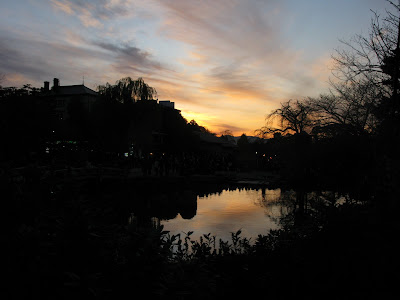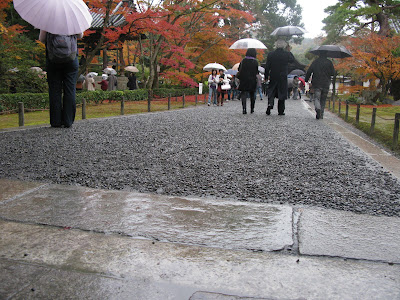
Obviously one of the greatest changes in moving to Japan, is diet. We have land, they have sea. My appreciation of fish has grown ten fold in the last couple years, so that was one thing I could look forward to. One hang up that I had planned to hang at the door, was my preferences regarding meat. For just over a year now, I have narrowed my carnivorous scope to animals raised humanely. This worked beautifully back home, with the farmer’s market I knew exactly where my meal was coming from.
 With my personal restriction designed as a critique of America’s food system, I had never planned to bring my concerns abroad. Yet being here, I find it quite difficult to shift on the matter. I walk a line of desire to try new things, wanting to be a good guest, and concern for the animal’s well being. This is a tough spot to be in, especially here.
With my personal restriction designed as a critique of America’s food system, I had never planned to bring my concerns abroad. Yet being here, I find it quite difficult to shift on the matter. I walk a line of desire to try new things, wanting to be a good guest, and concern for the animal’s well being. This is a tough spot to be in, especially here. In Japan, meat is not on the side. It is inside, on top, underneath, fused to the rest of the meal. You can order something without meat, but it will have meat. You can point out the bacon atop your salad, and they will tell you it is not meat. It is just a flavoring agent.
In Japan, meat is not on the side. It is inside, on top, underneath, fused to the rest of the meal. You can order something without meat, but it will have meat. You can point out the bacon atop your salad, and they will tell you it is not meat. It is just a flavoring agent. This is a hefty change for a formerly Buddhist/vegetarian nation. The word, vegetarian, has dropped from their vocabulary. Most people do not understand it, and not because it is English. The concept is just far too foreign. It is like the Inuit tribes with no word for murder. The practice does not exist, so why speak of it? The advice typically given to foreigners in my situation, is to say that I am “allergic” to meat. Allergies have greater universal understanding. While this tactic may work for some, it completely falls short of my purposes. Keeping the undesirable meat off the plate is half the battle, while the process of rejection is the other half.
This is a hefty change for a formerly Buddhist/vegetarian nation. The word, vegetarian, has dropped from their vocabulary. Most people do not understand it, and not because it is English. The concept is just far too foreign. It is like the Inuit tribes with no word for murder. The practice does not exist, so why speak of it? The advice typically given to foreigners in my situation, is to say that I am “allergic” to meat. Allergies have greater universal understanding. While this tactic may work for some, it completely falls short of my purposes. Keeping the undesirable meat off the plate is half the battle, while the process of rejection is the other half. There is the possibility that the Japanese treat their animals with the utmost care. I do not know of this one way or the other, but in this realm I pair my ignorance with cynicism. It is here that the language barrier is most trying. My greatest desire in learning the language, is to learn a little more about the food. Even then, the story may not change much. It seems to be the case that while the Japanese love food, they have no love for knowledge of food. At least not when it pertains to sourcing.
There is the possibility that the Japanese treat their animals with the utmost care. I do not know of this one way or the other, but in this realm I pair my ignorance with cynicism. It is here that the language barrier is most trying. My greatest desire in learning the language, is to learn a little more about the food. Even then, the story may not change much. It seems to be the case that while the Japanese love food, they have no love for knowledge of food. At least not when it pertains to sourcing. For all its flaws, America has a growing awareness of food issues, and desire to know where food comes from. Though I think there is much more to accomplish, I see that we are on the right track.
For all its flaws, America has a growing awareness of food issues, and desire to know where food comes from. Though I think there is much more to accomplish, I see that we are on the right track. For the first two months, I went with the flow. I did not intentionally purchase meat for my meals, but I did eat what was given me. To be particular, would have been especially difficult for my 1.5 months at the Ikawa mountain school. While there, I ate school lunches with the staff and students, and dormitory dinners with the teachers. Breakfast was usually just fruit. I was also more apt to sample things out and about downtown.
For the first two months, I went with the flow. I did not intentionally purchase meat for my meals, but I did eat what was given me. To be particular, would have been especially difficult for my 1.5 months at the Ikawa mountain school. While there, I ate school lunches with the staff and students, and dormitory dinners with the teachers. Breakfast was usually just fruit. I was also more apt to sample things out and about downtown.Upon concluding my time at Ikawa, and returning to the heart of the city, I decided to be more proactive with my dietary concerns. Since October I have been a vegetarian in respect to land animals. If by chance, I stumble upon a small farm with some lovely chickens, or a nice slab of bacon, I may be inclined to get some. But until such an instance happens, I do not know where my meal comes from, and thus I shall avoid it all together.
 Sourcing from the sea, is another can of worms that I do not wish to open today. I eat the variety of critters that come from the ocean, but even that, only to a limited extent. And less and less so.
Sourcing from the sea, is another can of worms that I do not wish to open today. I eat the variety of critters that come from the ocean, but even that, only to a limited extent. And less and less so.It is unfortunate to be limiting my eating experience this year abroad. Though I will have it no other way. I do like to try new things where I can. My job is to share both the English language and western culture. Being an outspoken vegetarian seems to fit under the cultural understanding bit. While I do not preach to the students, I am eager to field their questions as to why I am eating something different. Accept it or not, it is good to know that it exists.































